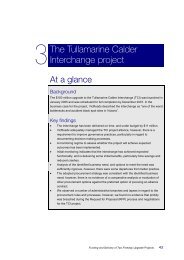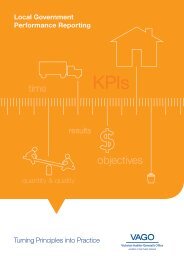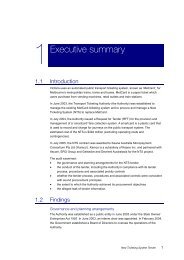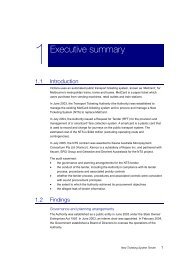Delivering HealthSmart Report - VAGO
Delivering HealthSmart Report - VAGO
Delivering HealthSmart Report - VAGO
Create successful ePaper yourself
Turn your PDF publications into a flip-book with our unique Google optimized e-Paper software.
2.1.7 How program costs were to be funded<br />
About the HealthSMART strategy<br />
The funding model for the HealthSMART program requires implementation costs to be<br />
shared between DHS and health agencies. This is consistent with the partnership<br />
approach adopted for the program in the strategic plan.<br />
In setting the level of agency contribution, DHS required each agency to contribute<br />
30 per cent of the implementation costs for clinical systems, and 20 per cent of the cost<br />
for all other systems. DHS expected health agencies to fund their contribution by<br />
reallocating internal funds currently used for ICT systems and infrastructure.<br />
Under the ‘co-contribution’ funding model DHS provides the bulk of the implementation<br />
costs. Specifically, the department:<br />
• funds the license costs, state-wide planning, state-wide design and required<br />
technology<br />
• funds vendor costs for agency implementations<br />
• contributes to local project costs (particularly through funding of a project<br />
manager)<br />
• covers running costs for the first twelve months of each agency’s use of the<br />
system<br />
• subsidises ongoing running costs of HealthSMART Shared Services until there is<br />
adequate uptake of the system.<br />
Implementation costs to be borne by the health agencies include:<br />
• funding of a project team (excluding the DHS-funded project manager position)<br />
• funding for staff training (largely backfilling of staff attending training)<br />
• funding of the integration of HealthSMART applications with local systems.<br />
In addition, health agencies were expected to bear the operating and maintenance<br />
costs of each system beyond the first year after going live. These costs include:<br />
• fees paid to HealthSMART Shared Services for hosting and support of<br />
HealthSMART applications<br />
• any required agency infrastructure upgrades and maintenance—to keep<br />
infrastructure such as computers and communication networks in an adequate<br />
condition to effectively operate HealthSMART applications.<br />
In its 2003 funding submission to government, DHS budgeted for $250.5 million to be<br />
expended by DHS on the program with the balance of $72.9 million to be funded by<br />
the health agencies involved in the program.<br />
In June 2006, DHS increased its budget contribution for HealthSMART by $34.8 million<br />
to $285.3 million. Budgeted contributions required from health agencies fell by<br />
$47.5 million, from $72.9 million to $25.4 million.<br />
<strong>Delivering</strong> HealthSMART — Victoria's whole-of-health ICT strategy 17
















